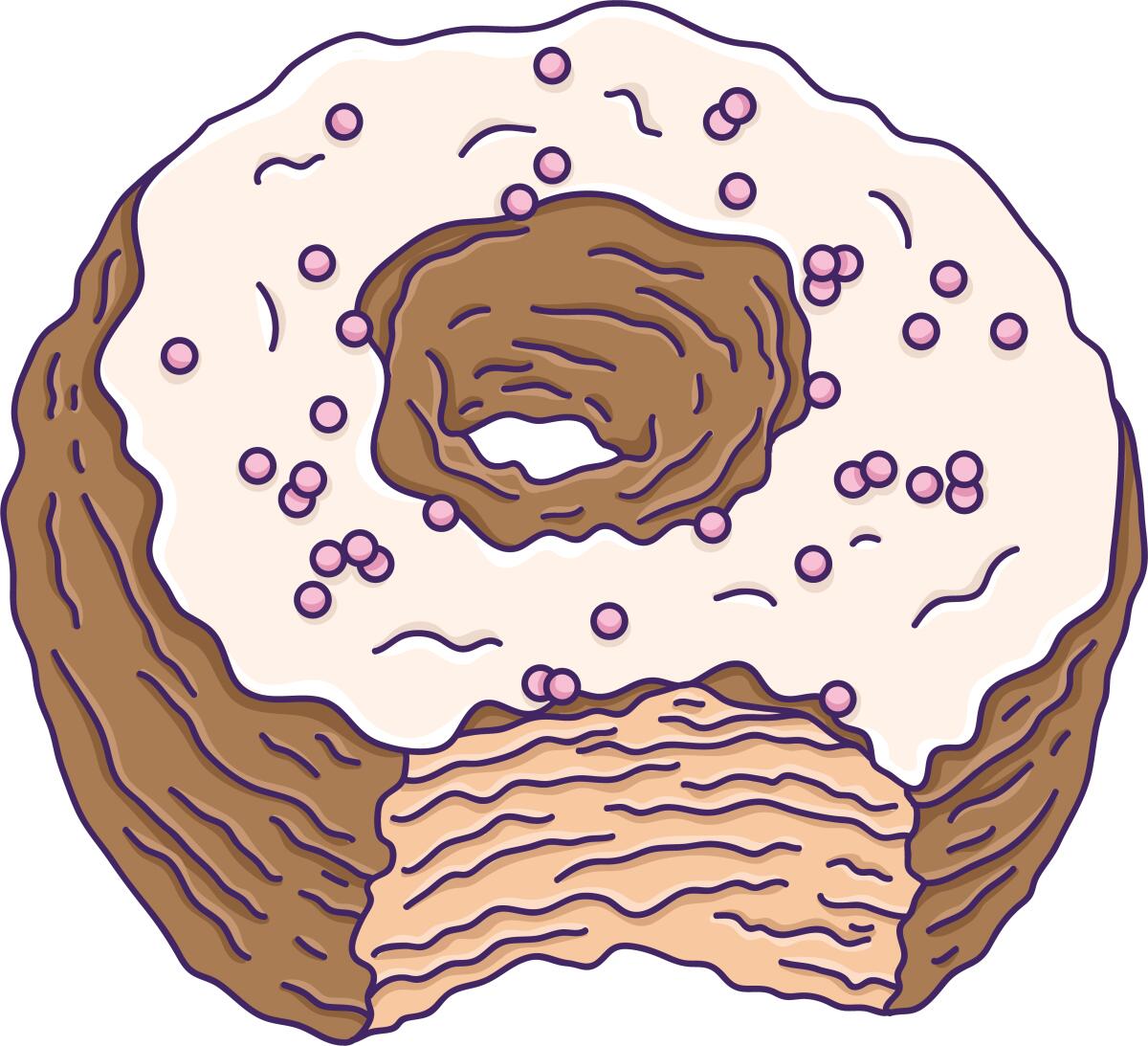Emma Stone-worthy Portuguese egg tarts and more food in movies

The bliss of first bites, illicit cherries jubilee, Miyazaki’s gluttons ... and the crookie? Oh, what hath the Cronut wrought? I’m Laurie Ochoa, general manager of L.A. Times Food, with this week’s Tasting Notes.
‘Furious munching’
The first bite of an incredibly delicious new food can lead to reverie, rapture, stomach aches or, to quote the caption writer of this Guardian story on Emma Stone eating 60 Portuguese custard tarts for her Oscar-nominated performance in “Poor Things” ... “furious munching.”
“Who made these? We need more!” Stone’s growing-up-fast child in a woman’s body Bella Baxter declares when she eats her first pastel de nata in Lisbon.
“No more,” says Mark Ruffalo’s nefarious Duncan Wedderburn, who wants to whet her appetite for more sex, not pastry. “One’s enough. Any more is too much.”
Headstrong Bella ignores Wedderburn and binge eats tart after tart until she gets sick and moves on to her next adventure.
It brought to mind the furious-munching breakfast scene in “Fantastic Mr. Fox” when Meryl Streep’s Mrs. Fox serves George Clooney’s Mr. Fox a plate of pancakes.
Of course, there are several great food moments among the films nominated for Oscars this year. Studio Ghibli’s guiding force Hayao Miyazaki, for instance, is known for his gorgeous and sometimes provocative food moments, which range from the loving mother figure slathering butter and jam on bread for Mahito, the boy in “The Boy and the Heron” (nominated for animated feature), to scenes that reveal the glee and greed of gluttony.
I’ve always worried that I would have succumbed to the temptation of a magical market’s feast for the taking in “Spirited Away” and turned into a pig like the parents in that 2001 film. In “The Boy and the Heron” we see a bit of that impulse when the elderly women working at Mahito’s new home descend on the supply of canned food that has just arrived.

Director Alexander Payne gives us his version of Jack Nicholson’s “Five Easy Pieces” “hold-the-chicken” diner scene in “The Holdovers” (nominated for five Oscars) when Paul Giamatti’s cynical history professor and Da’Vine Joy Randolph’s mother-in-mourning try to order flaming cherries jubilee for underage Angus (Dominic Sessa).
“What kind of fascist hash foundry are you running here?” Giamatti’s character snarls when the unyielding waitress refuses to serve Angus the alcohol-fueled dessert or even bring it to a table with a minor because he might take an illicit bite.
Randolph’s character Mary plays it cool, hiding her irritation as she politely asks the waitress, “Excuse me, do you by chance have cherries?” She then orders cherries and ice cream to go and the three of them head to the parking lot, where they douse the takeout dessert with Jim Beam and light everything on fire.
The most spectacular movie cooking, not unexpectedly, is the extended meal making — the opposite of quick-cut TikTok how-to recipes — in Trần Anh Hùng’s “The Taste of Things,” nominated for this year’s international feature film Oscar.

Juliette Binoche and Benoît Magimel play cook and gourmand, lovers who bond over their art.
“Excelling is the passion of any artist,” Binoche told Times contributor Tim Grierson last month. “For me, during the film, the cooking was like painting — it would be the same thing. A lot of times, we do things without thinking about it, without being involved. Suddenly, when it becomes meaningful, it’s purposeful.”
Still, as hungry as I got watching the cooking scenes in “The Taste of Things” — conceived with the help of food historian Patrick Rambourg and Michelin three-star chef Pierre Gagnaire — there was something about the primal tart eating by Stone’s Bella in “Poor Things” that captured the wonder and love-at-first-bite delight we can experience when we encounter new flavors.
I think about the long-ago Halloween when I took my daughter trick-or-treating for the first time. The preschool-age Isabel sat in her “Little Mermaid” costume with young Devin, son of this paper’s late arts and culture editor Kelly Scott, on the living room floor surrounded by the candy they’d gathered from neighbors. Neither could believe the bounty as they opened mini candy bar after mini candy bar.
“It’s ours!” a chocolate-lipped Isabel exclaimed. “People gave it to us!”
Afraid the reverie would lead to stomach aches or worse, Kelly and I had to play the Ruffalo/Wedderburn role and eventually called, “No more.”
Last week, however, with those Portuguese custard tarts on my mind, I headed to Natas Pastries, which Fatima Marques opened nearly 20 years ago in Sherman Oaks. When writer Linda Burum first reviewed the bakery and restaurant in 2006, she and a friend devoured nearly a dozen custard tarts in one sitting — furious munching in the name of research.

“The tiny custard tart, formally known as pasteis de nata, is renowned in Portugal for the way its egg-rich crème brûlée-like filling contrasts with the sumptuous crackle of a parchment-textured shell,” Burum wrote. “How do they stay crisp? we ask each other, reaching for yet another.”
Natas, which is open only Friday through Sunday, has expanded in size since Burum wrote about the bakery and cafe. There’s a small dining room extending from the bakery adorned with blue-and-white tile. Among the Portuguese cafe specialties are the soups caldo verde and sopa de pedra. There are four bacalhau or salt cod dishes for dinner, plus the seafood stew caldeirada and piri-piri chicken.
I tried the Francesinha sandwich, a baroque take on a croque-madame, dripping with melted cheese, ham, Portuguese sausage and topped with an egg and molho de francesinha sauce made with tomato and beer. It’s so wild and extravagant I can easily imagine Bella digging into it amid the color-drenched, hyper-real Lisbon sets of “Poor Things.”
But if you’re planning an Oscar party this weekend, I would recommend serving pasteis de nata — or maybe the similar Chinese egg tarts dan tat, which so many Southern Californians know from dim sum meals. (Jenn Harris has an excellent guide on where to find them.) Get at least a dozen. Because contrary to the directive from ill-tempered Duncan Wedderburn, one is not enough.
Have a question?
Don’t miss ...
- Our Korea correspondent Max Kim, reporting from Seoul, has a fabulous story about how “a British YouTuber known as the ‘Korean Englishman’” changed the fortunes of Samyang Foods, the company “that pioneered Korean ramen,” including Buldak “fire chicken” ramen. His “video proved a lifeline that would carry it through both deep financial trouble and self-inflicted scandal.”
- Bill Addison’s review of Jonathan and Deany Santana’s El Bacano in North Hollywood — L.A.’s only Dominican restaurant — will make you hungry for a breakfast of mangú or mashed plantains with los tres golpes ... “the three hits”: two fried eggs, griddled salami and queso frito. When you’re asked whether you want your plantains green or ripe, Addison advises, say “both”!
- Jenn Harris sets out to find L.A.’s best Northern Chinese and Taiwanese beef rolls. She finds eight that are worthy.
- After six years, the Topanga Farmers Market has made a comeback. Stephanie Breijo was there for the opening.
- Mandrake, the bar and artists’ gathering spot opened by Flora Wiegmann, Drew Heitzler and Justin Beal 18 years ago on the edge of Culver City, across the street from the internationally famous Blum Gallery, is closing March 16. Assistant Food Editor Danielle Dorsey talked with Wiegmann about the decision and has details about the space’s transition to the new bar concept called No Smoking.
- Among the eating and drinking places writer Todd Martens highlights in his “This must be downtown L.A.” neighborhood guide are Redbird, Moonlark’s Dinette, Sonoratown and the Wolves.
- And can a hotel shut down its restaurants after workers try to unionize, then reopen two days later with “a whole new set of workers”? That’s the question Food reporter Cindy Carcamo investigates after downtown L.A.’s Hotel Figueroa became the subject of a complaint filed with the city attorney’s office.
Finally ...

What hath the Cronut wrought? Since Dominique Ansel’s 2013 croissant-doughnut invention went viral, the portmanteau croissant crossbreeding hasn’t stopped. The crogel. The cruffin. But do we really need the crookie? The photo on the story by the BBC’s Emily Monaco doesn’t look appetizing — blobs of chocolate-chip cookie dough plopped on a croissant. But maybe if I went to Paris’ Boulangerie Louvard, where the crookie was invented, furious munching would ensue.
Eat your way across L.A.
Like what you're reading? Sign up to get it in your inbox every week.
You may occasionally receive promotional content from the Los Angeles Times.

Eat your way across L.A.
Get our weekly Tasting Notes newsletter for reviews, news and more.
You may occasionally receive promotional content from the Los Angeles Times.




